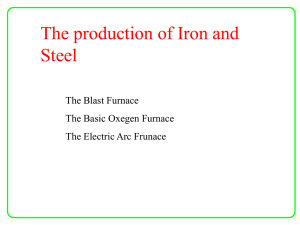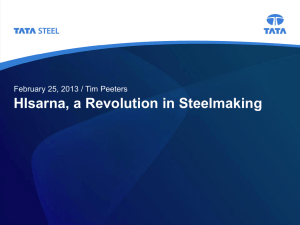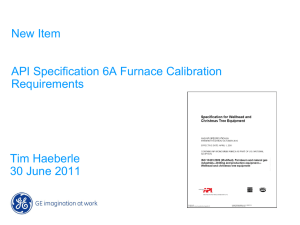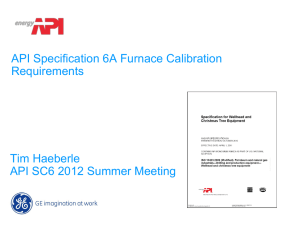Blast Furnace - Metal Casting Theory and Design
advertisement
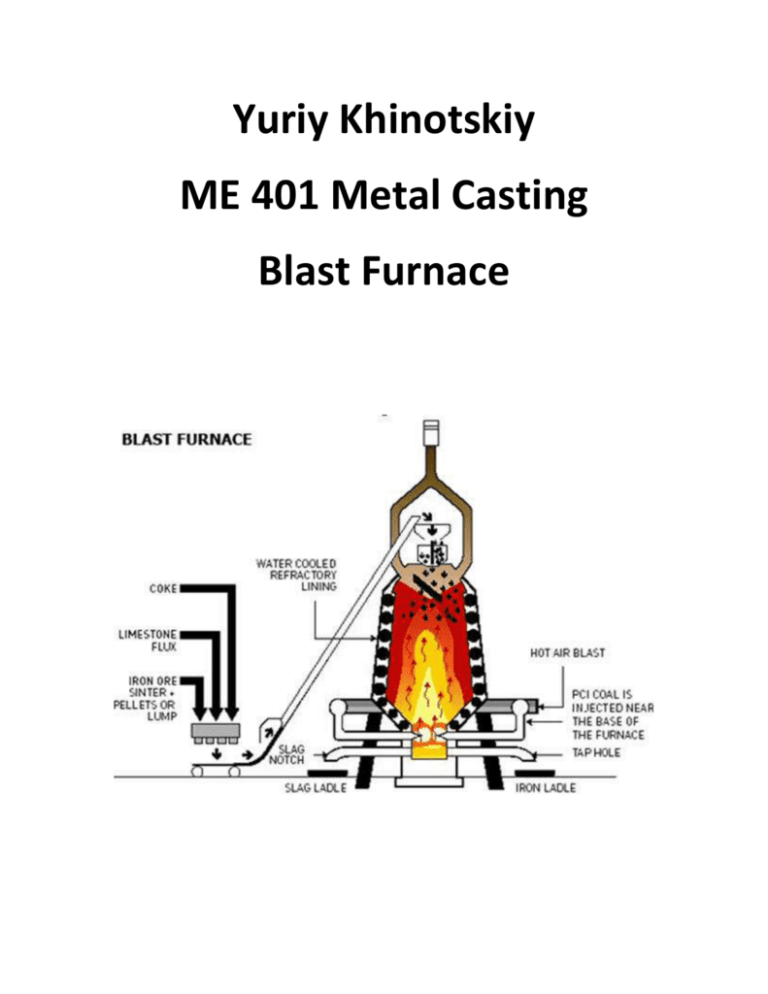
Yuriy Khinotskiy ME 401 Metal Casting Blast Furnace Introduction The blast furnace is a large steel stack that is lined with refractory brick which iron ore, coke and limestone are added into the top of the furnace and preheated air is blown into the bottom of the furnace. The purpose of the blast furnace is to chemically convert and physically reduce metals into a liquid form. These furnaces are generally used to smelting and refining iron oxides and were widely used for the creation of steel. A blast furnace has a typical cone-like shape and the sections from top to bottom are: the throat where the burden surface is, the stack where the ores are heated and reduction starts, the bosh parallel or belly where the active coke zone is, the bosh where the reduction is completed and the ore are melted down, and the hearth where the molten metal is collected and cast using the taphole. A detailed schematic of the section are shown in Figure 1. Figure 1: Section of the Blast Furnace Blast furnaces existed in China around the 5th century BC and also in medieval Europe. The furnace initially used charcoal but in 1709, coke was substituted as the fuel source. Then in 1828, the efficiency of the blast furnace was further increased by preheating the blast. The blast furnace is still an important part of the iron production. Modern furnaces are highly efficient, with the largest furnaces having a volume of about 5580 meters cubed (190,000 cubic feet) and can produce about 80,000 tonnes of iron per week. Equipment and Construction To construct a blast furnace there are important equipment that are needed. The first is a hot blast stove. This is used to preheat air with temperature between 1000 and 1250 degrees Celsius before it is delivered to the furnace using the tuyeres. Next, a stock house is needed. Iron ore and coke are sent to the stock house to be screened and weighed before being sent to the furnace. The stock house is able to make corrections for coke moisture automatically. From the stock house, the iron ore and coke are brought into the top of the furnace using a conveyer belt and are discharged in separate layers. Also, a system of gas cleaning is needed. The top gas of the furnace leaves using the uptakes and a down, the top gas also contains many fine particles which must be removed. To do this the top gas needs to be lead through a dust catcher and a wet cleaning system. A casthouse is also needed; liquid metal and slag are moved from the hearth of the furnace using the taphole to the casthouse for transportation by ladles. And finally a slag granulation is needed to quench the resulting slag to be used for cement manufacturing. There are two main techniques to support the constructions of a blast furnace. The first is the classic design which uses a supporting ring, or lintel, at the bottom of the shaft which the higher levels of the furnace rest upon. The thermal expansion required for the installation of this technique should be below the lintel in the bosh and belly area. The second option is a freestanding construction that needs an independent support for the blast top and the gas system. The thermal expansion required for the installation of this technique needs to be at the top of the furnace. The top blast of the blast furnace is closed because of the high top pressures associated with modern furnaces and there are two different systems for dealing with this. The first is a double bell system which is often equipped with a movable throat armour. The second system is bell less top which allows for easier ore distributions. Process The blast furnaces use coke and coal as the main fuel source and uses sinter, pellet and lump ore as the iron-bearing components. The furnace generally focuses of producing flat products of steel. Hot metal is produced from the furnace and is transported in liquid form to a steel plant where refinement occurs to remove elements such as sulfur, carbon, manganese, silicon and phosphorous. In order for the steel plant to have favorable performance, the content of the hot metal should include: silicon between 0.3% and 0.7%, manganese between 0.2% and 0.4%, and phosphorus in the range of 0.06% and 0.08% or 0.1% and 0.13%, the temperature should also be as high as possible. In the blast furnace process, iron ore and the reducing agents are turned into hot metal and slag is formed from the gangue of the ore burden to the ash of the coke and the coal. The hot metal and the liquid lag remain separate from each other with the slag floating on top of the more dense iron until the iron is separated in the casthouse. Ore and coke are charged in discrete layers at the top of the furnace and remain there until the temperature is raised high for the melting of the iron ore to begin. At any moment an operating blast furnace contains: layers of iron ore and coke, an area where the ore starts to soften and melt, an area where there is only coke, liquid metal, and slag, and a stable pile of coke at the bottom of the furnace. To start the process, the furnace is filled with alternating layers of coke and iron ore. A cooled copper conical pipe, called a tuyere, is used to blow a hot blast into the furnace. Then the hot blast gasifies the reducing components in the furnace which turns the oxygen in the blast to carbon monoxide which causes the gas to have a high flame temperature of 2100 to 2300 degrees Celsius. Then this hot gas ascends through the furnace and heat up the coke in the bosh and belly area which causes the iron ore to melt in the burden. It also heats up the material in the shaft zone. While the iron ore is melting, oxygen is removed from the ore by a chemical reaction. Also during the melting process, the iron ore produces liquid metal and slag which drips down to the hearth and is casted through the taphole. During the end of the process, additional coke is used for the final reduction of the iron oxide and then carbon dissolves into the liquid metal. The process generally takes between 6 and 8 hours. Conclusion The blast furnace system for casting has been used since the 5 th century BC. With improved technology, coke was substituted for charcoal to improve the efficiency of the furnace. To further improve the efficiency of the furnace, the blast was determined to need preheating. This furnace generally deals with the production of iron and since has become a high producer of steel. The furnace generally focuses on making flat steel and takes about 6 to 8 hours. References Birks, Steve. "How it works: The Blast Furnace." n.d. The Potteries. 26 July 2012. <http://www.thepotteries.org/shelton/blast_furnace.htm>. Irvine, James. Antonine Education. n.d. 26 July 2012. <http://www.antonineeducation.com/jirvine/chemistry_gcse/C1A/c1al9.htm>. Maarten Geerdes, H. Toxopeus. Modern Blast Furnace Ironmaking: An Introduction. 2009. Steel.org. "Iron Ore Processing for the Blast Furnace." n.d. Steel.org. 26 July 2012. <http://www.steel.org/~/media/Files/AISI/Making%20Steel/Article%20Files/ironore.ashx>. Wikipedia. "Blast furnace." 24 Juky 2012. Wikipedia. 26 July 2012. <http://en.wikipedia.org/wiki/Blast_furnace>.
